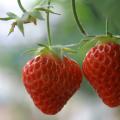Wépion strawberry
Wépion strawberry refers to a distinctive variety of strawberry cultivated primarily in the town of Wépion, located along the Meuse River in the province of Namur, Belgium. Renowned for its unique flavor, size, and juiciness, the Wépion strawberry has garnered a reputation as one of the finest strawberry varieties in Europe. This article delves into the history, cultivation practices, and cultural significance of the Wépion strawberry.
History[edit | edit source]
The cultivation of strawberries in Wépion dates back to the early 20th century. The region's microclimate, characterized by mild temperatures and high humidity, creates an ideal environment for strawberry cultivation. Over the years, the Wépion strawberry has become a symbol of local heritage and pride, with its cultivation passed down through generations of farmers.
Cultivation[edit | edit source]
The cultivation of Wépion strawberries is labor-intensive, requiring meticulous care throughout the growing season. Farmers in Wépion employ traditional farming techniques, often eschewing modern agricultural technology in favor of manual labor. This hands-on approach ensures the highest quality of fruit.
Strawberries in Wépion are typically grown in open fields and are harvested from late spring to early summer. The region's growers place a strong emphasis on sustainable farming practices, including the minimal use of pesticides and the promotion of biodiversity.
Cultural Significance[edit | edit source]
The Wépion strawberry holds a special place in the cultural and gastronomic landscape of Belgium. Each year, the town of Wépion hosts a strawberry festival, attracting visitors from across the country and beyond. The festival features a variety of events, including strawberry tastings, cooking demonstrations, and contests.
In addition to its prominence in local festivals, the Wépion strawberry is celebrated in Belgian cuisine. It is used in a wide range of dishes, from simple desserts to elaborate pastries, and is often paired with chocolate, another Belgian specialty.
Economic Impact[edit | edit source]
The cultivation of Wépion strawberries is a significant source of income for the local economy. The demand for these strawberries extends beyond Belgium's borders, with exports to neighboring countries. The industry supports not only local farmers but also contributes to the tourism sector, as visitors come to Wépion to experience its famed strawberries firsthand.
Challenges[edit | edit source]
Despite its popularity, the Wépion strawberry industry faces several challenges. Climate change poses a threat to the delicate microclimate of the region, potentially impacting strawberry yields. Additionally, the labor-intensive nature of strawberry cultivation presents economic challenges, particularly in the face of cheaper, mass-produced strawberries.
Conclusion[edit | edit source]
The Wépion strawberry is more than just a fruit; it is a symbol of Belgian heritage, a testament to the dedication of local farmers, and a beloved ingredient in Belgian cuisine. As it navigates the challenges of the 21st century, the Wépion strawberry continues to be a source of local pride and a cherished delicacy for those who seek it out.
Navigation: Wellness - Encyclopedia - Health topics - Disease Index - Drugs - World Directory - Gray's Anatomy - Keto diet - Recipes
Search WikiMD
Ad.Tired of being Overweight? Try W8MD's physician weight loss program.
Semaglutide (Ozempic / Wegovy and Tirzepatide (Mounjaro / Zepbound) available.
Advertise on WikiMD
WikiMD is not a substitute for professional medical advice. See full disclaimer.
Credits:Most images are courtesy of Wikimedia commons, and templates Wikipedia, licensed under CC BY SA or similar.Contributors: Prab R. Tumpati, MD

